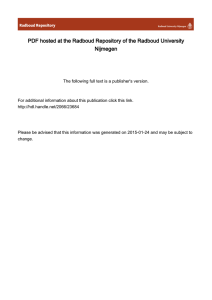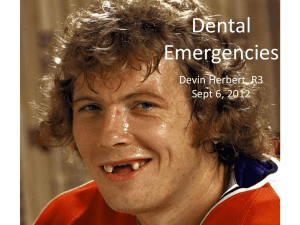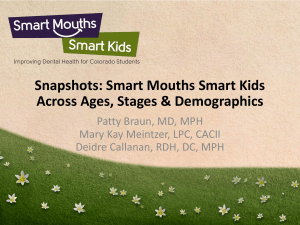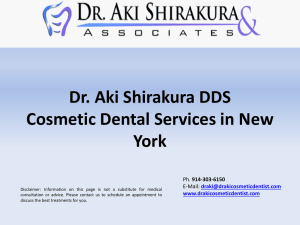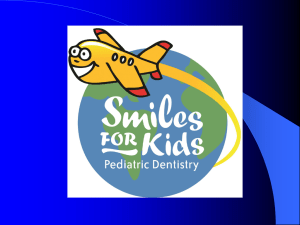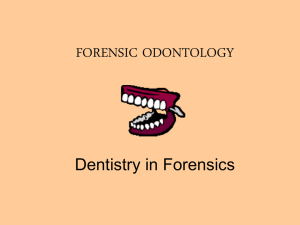Prezentace aplikace PowerPoint
advertisement
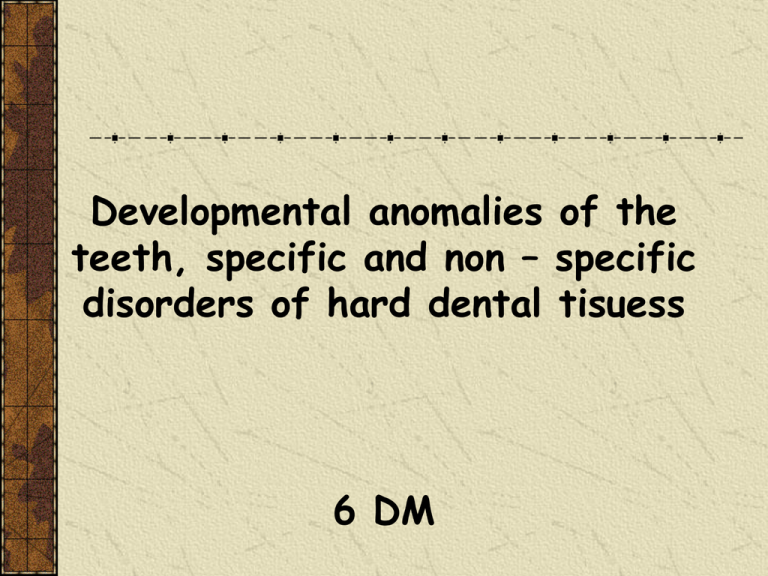
Developmental anomalies of the teeth, specific and non – specific disorders of hard dental tisuess 6 DM Developmental anomalies - tooth development is strict under genetic control - disturbances in tooth development result from gene mutation - tooth development may be disturbed at different stages of morphogenesis - definitive result depends on the timing and the type of insult Developmental anomalies Disturbances in tooth development: numerical variations (missing or supernumerary teeth) variations in size of teeth variations of shape of teeth disturbances in eruption Developmental anomalies Numerical variations 1.Hypodontia - number of teeth is decrease - the most commonly missing teeth are: the third molars, second premolars, maxillary lateral incisors - oligodontia, anodontia, agenesis Developmental anomalies Numerical variations 1.Hypodontia in deciduous dentiotion: - prevalence 0.1 – 0.7% - central incisors - oligondontia and anodontia is rare, may be found in connection with ectodermal dysplasia Developmental anomalies Ectodermal dysplasia: - describes a group of developmental, often inherit, disorders involving the ectodermally structures(hair,teeth, nails, skin and sweat glands) - presentation:multiple missing teeth, fine, sparse hair, dry skin, maxillary hypoplasia, eversion of the lips, pigmentation around the mounth and eyes. The teeth are conical, small, often with a large diastema. Developmental anomalies Numerical variations 1.Hypodontia in permanent dentiotion: - prevalence 6 – 10% - usually affects 2 or more teeth in 50% of the cases - often occures symmetrical hypodontia - particular relation with the microdontia Developmental anomalies Solitary median maxillary central incisor syndrome - is very rare - midline symetrical maxillary central incisor - can be associated with cleft palate, choanal stenosis, umbilical hernia, hypoplasia of sella turcica, pituitary dysfunction, growth hormone deficiency Developmental anomalies Numerical variations 2. Hyperodontia - number of the teeth is increse - is quite rare as hypodontia Frequency: primary teeth 0,3 - 0,8% permanent teeth 1,0 – 3,5% Developmental anomalies Numerical variations 2. Hyperodontia - shape is conical or normal - supernumerary teeth can erupt or cause anomalous eruption of neighbouring teeth - most frequent is mesiodens - part of syndrom cleidocranial dysplasia Developmental anomalies Cleidocranial dysplasia: - short stature - aplasia or hypoplasia of clavicles - delayed ossification - delayed eruption of teeth - dentigerous cyst formation Developmental anomalies a) Dentes praelactales - frontal region in a newborns - no roots Th: extraction Developmental anomalies Variations in tooth size: 1. Macrodontia - teeth are larger than normal - true macrodontia involving the whole dentition 2. Microdontia - one or more teeth are smaller than normal - most affect the maxillary third molars General microdontia: is a rare conditionoccuring in connection with congenital Local microdontia: involving single teeth, associated with hypodontia 3. Rhizomicry -lenght of the root is shorter than the height of the crown -connected with osteoporosis - predominantly affecting maxillary incisors and premolars Developmental anomalies Variations on tooth shape 1. Dens invaginatus - malformation due to an invagination of enamel epitelium resulting in a chanel or lumen surrounded by hard tissues within the tooth. The anomaly occurs most frequently in the palatal surface of max. lateral incisor. 2. Conical peg-shaped tooth Developmental anomalies Variations on tooth shape 3. Taurodontism - elongated root- stem with the furcation more apical than normally 4. Double formation of teeth a) concrescence- two normal appearing crowns are present and the fusion involves only the cementum Developmental anomalies Variations on tooth shape b) Fusion – union in dentin and/or enamel between two or more normal teeth c) Gemination – incomplete division of a tooth germ or a union between normal and a supernumerary tooth 5. Dnes evaginatus - is an extra cusp, usually in the central groove or ridge of a posterior teeth and in the cingulum of the central or lateral incisor Developmental anomalies 6. Dens in dente - is a condition resulting from invagination of the inner enamel epithelium producing the appearance of a tooth within a tooth 7. Dilaceration - an abnormal bend of the rooth during its development and is thought to result from a traumatic episode Developmental anomalies Variations in tooth eruption a) tooth retention b) tooth semiretention c) anomalous position after eruption Non – specific disorders of hard dental tisuess 1) Hypoplasia 2) Hypomineralization Hypoplasia: Ethiology:- metabolic disorders, fever, endocrinic disease,trauma, inflammation Cl. picture: anomalous shape of dental crown, grooves and fissures, color-dark brown, yellowbrown. Non – specific disorders of hard dental tisuess Hypomineralization: Ethiology:- metabolic disorders, fever, endocrinic disease,trauma, inflammation Cl. picture: normal shape of dental crown, in hard dental tisuess are quality changes. Color- white or brown smudges, localization on labial surfaces of incisors Specific disorders of hard dental tisuess Dysplasia of hard dental tisuess 1.DENTIN DYSPLASIA Ethiology: ingestion of chemicals, prematurity birthweight, severe malnutrition, bilirubinemia Typ I: radicular dentin dysplasia or rootless tooth Typ II: anomalous dysplasia of dentin with frequent discoloration of primary teeth, permanent teeth often appear normal clinically but have thistletube formed pulp chamber. Pulp stones may occure. Specific disorders of hard dental tisuess Chronic toxicity 2.Dental Fluoride induced defect fluorosis Dental fluorosis is a qualitative defect of enamel, resulting from an increase in concentration within the F microenviroment of the ameloblasts during enamel formation Manifestation • very mild white flecks • mild-fine white lines • moderate very chalky, opaque enamel • severe outher enamel mottling and loss of proportion of the Specific disorders of hard dental tisuess 3. Tetracycline defects - TTC has a strong affinity to mineralized tisuess, primary to dentin and bones - dentin defects are persistent - discolored horizontal bands may appear gray, bluish - discolored enamel has some translucency left - this ATB shoud not be prescribed to children below the age of 8, pregnant women, lactating mothers Specific disorders of hard dental tisuess 4. Molar – incisor hypomineralization - demarcated opacities in the perm. first molars, perm. incisors are often also involved - may affect one or all molars and one or more incisors - creamy white spot to yelowish brown discoloration - defect are porous Specific disorders of hard dental tisuess Subj. symptoms: - shooting pain during brushing teeth or breathing cold air Ethiology: - unknown, but suggestion are: medical problem related to birth, respiratory diseases during first 3 years of life Specific disorders of hard dental tisuess Amelogenesis imperfecta Definition:AI represents a roup of condition, genomic in origin, which affect the structure and clinical appearance of the enamel of all or nearly all teeth in a more or less equal manner, and which may be associated with morphologic or biochemical changes elsewhere in the body. Specific disorders of hard dental tisuess - autosomal dominant, autosomal recessive - incidence 1 in 14 000 - 4 major categories, 14 subtypes General manifestation: - normal intelligence, good general health Craniofacial/dental manifestation: - enamel defect that affects both dentitions, appearance is yellow- brown to orange depending on subtyp Specific disorders of hard dental tisuess Typ I:- hypoplastic (occuring in the histodifferation stage of tooth development, insufficient quantity of enamel is formed) TypII:- hypomaturation (defect of in enamel matrix apposition) Typ III:- hypocalcified (enamel is normal, but qualitatively the matrix is poor calcified with a resultant fracturing of the enamel surface. Hypocalcified enamel is soft and fragile, especially at the incisal region, and is easily fractured, exposing dentin. Specific disorders of hard dental tisuess Typ IV:- hypomaturation, hypoplastic with taurodontism (the enamel appears mottled with a yellow-brown color and is pittedon the facial surfaces. Molar teeth demonstrate taurodontism. Specific disorders of hard dental tisuess Dentinogenesis imperfecta Defect of predentin matrix that result amorphic, disorganized, and atubular circumpulpal dentin. - incidence 1 in 8000 - 3 basic types Shields type 1 Shields type 2 Shields type 3 Specific disorders of hard dental tisuess Shields type 1 - occurs with AI - inherit defect in collagen formation - osteoporotic brittle bones - bowing of the lips - blue sclera - bitemporal bossing - obliteration of pulp chamber,periapical radiolucencies, bulbous crowns, root fractures Specific disorders of hard dental tisuess Shields type 2 - hereditary opalescent dentin - autosomal dominant - affect primary and permanent dentition Shields type 3 - is rare, bell-shaped crown, - it has occured exclusively in a triracial isolated group in Maryland Specific disorders of hard dental tisuess Specific disorders of hard dental tisuess
